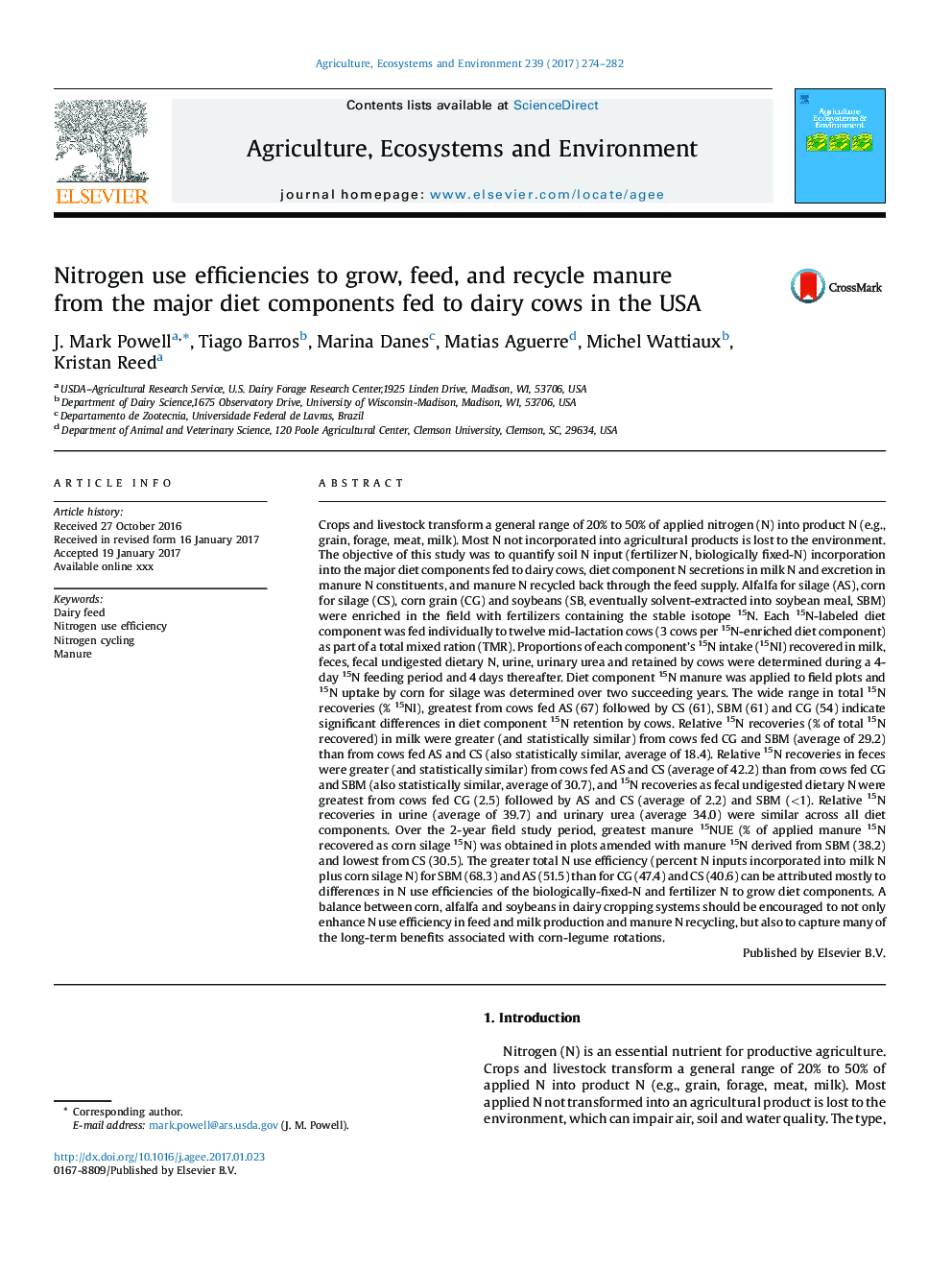| Article ID | Journal | Published Year | Pages | File Type |
|---|---|---|---|---|
| 5537934 | Agriculture, Ecosystems & Environment | 2017 | 9 Pages |
Abstract
Crops and livestock transform a general range of 20% to 50% of applied nitrogen (N) into product N (e.g., grain, forage, meat, milk). Most N not incorporated into agricultural products is lost to the environment. The objective of this study was to quantify soil N input (fertilizer N, biologically fixed-N) incorporation into the major diet components fed to dairy cows, diet component N secretions in milk N and excretion in manure N constituents, and manure N recycled back through the feed supply. Alfalfa for silage (AS), corn for silage (CS), corn grain (CG) and soybeans (SB, eventually solvent-extracted into soybean meal, SBM) were enriched in the field with fertilizers containing the stable isotope 15N. Each 15N-labeled diet component was fed individually to twelve mid-lactation cows (3 cows per 15N-enriched diet component) as part of a total mixed ration (TMR). Proportions of each component's 15N intake (15NI) recovered in milk, feces, fecal undigested dietary N, urine, urinary urea and retained by cows were determined during a 4-day 15N feeding period and 4 days thereafter. Diet component 15N manure was applied to field plots and 15N uptake by corn for silage was determined over two succeeding years. The wide range in total 15N recoveries (% 15NI), greatest from cows fed AS (67) followed by CS (61), SBM (61) and CG (54) indicate significant differences in diet component 15N retention by cows. Relative 15N recoveries (% of total 15N recovered) in milk were greater (and statistically similar) from cows fed CG and SBM (average of 29.2) than from cows fed AS and CS (also statistically similar, average of 18.4). Relative 15N recoveries in feces were greater (and statistically similar) from cows fed AS and CS (average of 42.2) than from cows fed CG and SBM (also statistically similar, average of 30.7), and 15N recoveries as fecal undigested dietary N were greatest from cows fed CG (2.5) followed by AS and CS (average of 2.2) and SBM (<1). Relative 15N recoveries in urine (average of 39.7) and urinary urea (average 34.0) were similar across all diet components. Over the 2-year field study period, greatest manure 15NUE (% of applied manure 15N recovered as corn silage 15N) was obtained in plots amended with manure 15N derived from SBM (38.2) and lowest from CS (30.5). The greater total N use efficiency (percent N inputs incorporated into milk N plus corn silage N) for SBM (68.3) and AS (51.5) than for CG (47.4) and CS (40.6) can be attributed mostly to differences in N use efficiencies of the biologically-fixed-N and fertilizer N to grow diet components. A balance between corn, alfalfa and soybeans in dairy cropping systems should be encouraged to not only enhance N use efficiency in feed and milk production and manure N recycling, but also to capture many of the long-term benefits associated with corn-legume rotations.
Related Topics
Life Sciences
Agricultural and Biological Sciences
Agronomy and Crop Science
Authors
J. Mark Powell, Tiago Barros, Marina Danes, Matias Aguerre, Michel Wattiaux, Kristan Reed,
